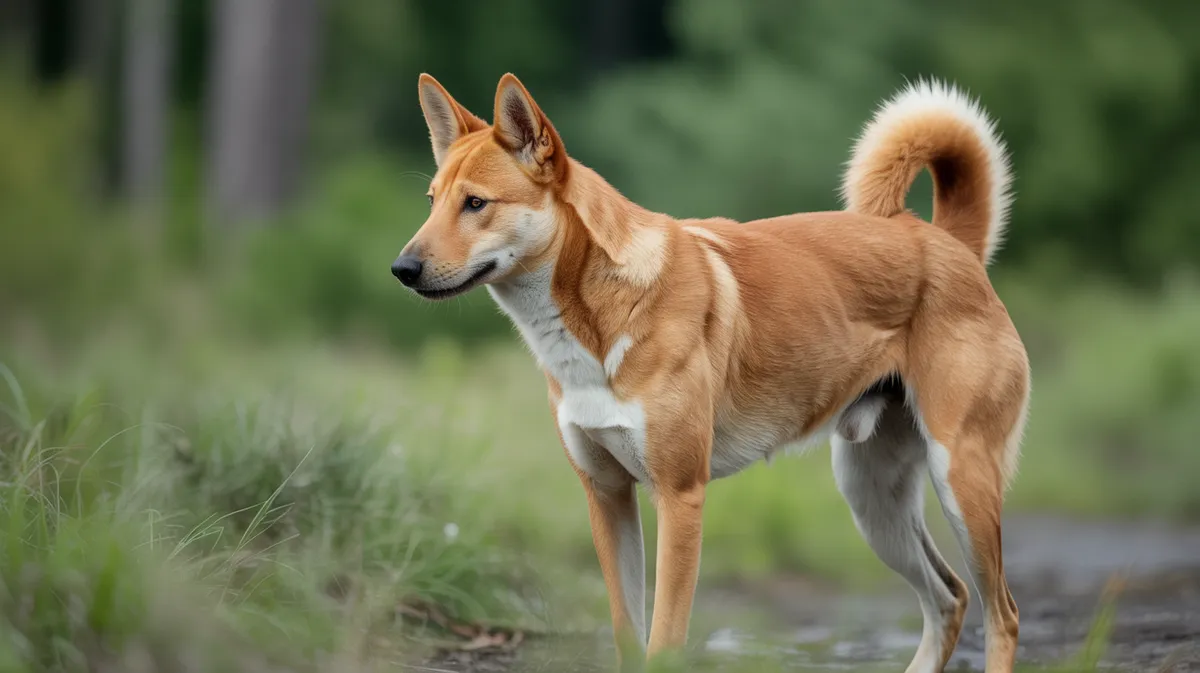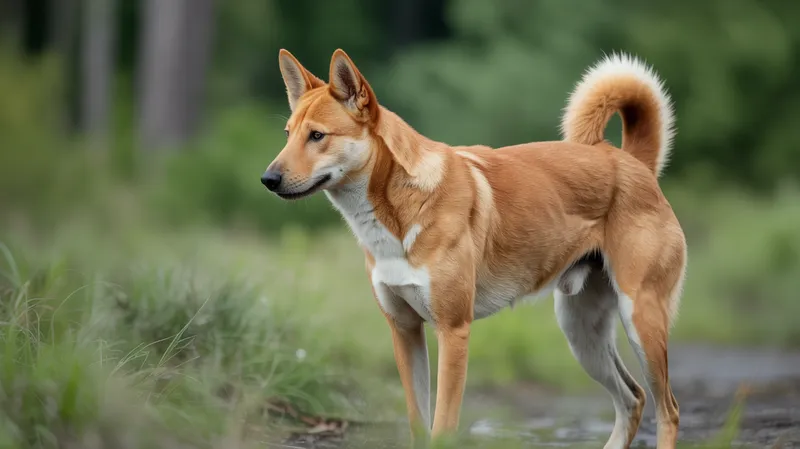
Carolina Dog
Canis lupus familiaris

Meet the Carolina Dog
The Carolina Dog, sometimes known as the American Dingo or Yellow Dog, is a medium-sized, free-ranging dog breed native to the southeastern United States. With a lean, athletic build, erect ears, and a characteristic fishhook tail, these dogs resemble primitive pariah dogs found in other parts of the world. Carolina Dogs are highly intelligent, independent, and display a strong pack mentality, making them both loyal companions and effective hunters. They are considered one of the few breeds in North America with truly ancient origins, having adapted to life in the forests and swamps. Their natural instincts and adaptability have allowed them to thrive in the wild for thousands of years.
Classification
Mammal
Habitat
Forest and grassland regions, particularly in the southeastern United States
Diet
Omnivore
Lifespan
12-15 years
Conservation
Least Concern
Weight
15-30 kg
📖Fascinating Facts
Primitive Ancestry
Carolina Dogs are thought to be one of the oldest dog breeds in North America, with a lineage dating back thousands of years.
Wild Habits
These dogs still exhibit many wild or primitive behaviors, such as digging snout pits and forming complex social structures.
Survival Skills
Carolina Dogs are highly adaptable and resourceful, able to survive independently in challenging environments such as swamps and forests.
📋Detailed Description
The Carolina Dog is a medium-sized, primitive dog breed with a lean, athletic build, typically weighing between 30 and 55 pounds (14–25 kg) and standing 17.75 to 19.5 inches (45–49.5 cm) at the shoulder. Its most distinctive features include a wedge-shaped head, large, erect ears, almond-shaped eyes, and a characteristic 'fishhook' tail that curves over the back. The coat is short to medium in length, dense, and weather-resistant, with the most desirable coloration being red-ginger with pale buff markings on the shoulders and muzzle. Anatomically, Carolina Dogs possess long limbs and a deep chest, adaptations that facilitate efficient movement through dense forests and open grasslands. Their dentition is robust, suited for an omnivorous diet that includes small mammals, insects, and plant material. Behaviorally, they are highly alert, intelligent, and display strong neophobic tendencies, often wary of unfamiliar objects or people. Socially, Carolina Dogs form loose, hierarchical packs in the wild, with complex communication involving vocalizations, body language, and scent marking. Reproduction occurs seasonally, with females exhibiting a single annual estrus, a trait shared with other primitive dog populations. Unique adaptations such as communal pup-rearing, exceptional scent-tracking abilities, and efficient foraging strategies have enabled the Carolina Dog to persist in the wild, largely independent of human intervention. Their ancient lineage is supported by genetic studies indicating close affinity to East Asian and Australasian pariah dogs, suggesting a deep evolutionary history in North America. These dogs are notable for their adaptability, resilience, and the retention of many behaviors typical of wild canids.
💡 Did you know?
Carolina Dogs are believed to be direct descendants of dogs that crossed into North America with Paleo-Indians over 8,000 years ago.
🔬Research & Sources
Wikipedia Summary
The Carolina dog, also known as a yellow dog, yaller dog, American dingo, or Dixie dingo, is a breed of medium-sized dog occasionally found feral in the Southeastern United States, especially in isolated stretches of longleaf pines and cypress swamps. Efforts to establish them as a standardized breed have gained the Carolina Dog breed recognition in two smaller kennel clubs and full acceptance into the breed-establishment program of one major kennel club.
Last Modified: 12/31/2024
🎭Behavior & Social Structure
Carolina Dogs are crepuscular, being most active during dawn and dusk, which helps them avoid both human activity and midday heat. In feral populations, they exhibit a wide range of foraging behaviors, including digging for roots and tubers, hunting small mammals, reptiles, and insects, and opportunistically scavenging. They are known for their cautious, investigative approach to novel stimuli, a behavioral trait called neophobia, which likely aids in predator avoidance and survival. Social interactions are structured around small, stable packs, typically consisting of a dominant breeding pair and their offspring, with clear social hierarchies maintained through subtle body language and vocalizations. Pack members cooperate in hunting, territory defense, and pup rearing. Scent marking is frequent, with both males and females using urine and feces to delineate territory. Daily routines involve patrolling territory, foraging, resting in concealed locations, and engaging in social grooming and play, which reinforces pack bonds. In domestic settings, Carolina Dogs retain many of these behaviors, displaying high intelligence, independence, and a strong prey drive, but also forming deep bonds with human families.
👶Reproduction & Life Cycle
Carolina Dogs exhibit a reproductive cycle more akin to wild canids than to most domestic breeds. Females typically come into estrus once per year, usually in late winter or early spring, which may be an adaptation to seasonal resource availability. Mating is monogamous within established packs, with the dominant pair producing most of the offspring. Gestation lasts approximately 60–63 days, after which the female gives birth to a litter of 3–6 pups in a secluded den, often dug in sandy soil or under dense vegetation. Both parents, and occasionally other pack members, participate in pup rearing, providing food, protection, and socialization. Pups are weaned at around 6–8 weeks and begin to accompany adults on foraging trips soon after. Juveniles remain with the natal pack for several months to a year, gradually dispersing to form new packs or join existing ones. This reproductive strategy, with limited annual breeding and communal care, enhances pup survival in challenging environments.
🛡️Adaptations & Survival
Carolina Dogs possess several physical and behavioral adaptations for survival in the wild. Their lean, muscular bodies and long legs allow for efficient travel over varied terrain, while their dense, weather-resistant coats provide protection against the elements. The fishhook tail serves as a visual signal in dense vegetation, aiding in pack cohesion. Acute senses of smell and hearing facilitate detection of prey and predators. Behavioral adaptations include neophobia, which reduces risk from unfamiliar threats, and a flexible, omnivorous diet that allows exploitation of diverse food sources. Communal pup-rearing and cooperative hunting increase reproductive success and resource acquisition. Seasonal breeding aligns pup rearing with periods of food abundance. Their ability to dig for food and create dens provides shelter and access to underground prey. These traits reflect evolutionary pressures similar to those faced by pariah dogs and wild canids worldwide.
📚Research Sources
🎨Cultural Significance
The Carolina Dog holds a unique place in the cultural history of the southeastern United States. Sometimes referred to as the 'American Dingo,' it is believed to be a descendant of ancient dogs that accompanied early human settlers across the Bering land bridge. Archaeological evidence suggests similar dogs were present in Native American communities, serving as companions, hunting aids, and possibly as spiritual symbols. In regional folklore, the 'yaller dog' is often depicted as a loyal, resourceful, and independent animal, embodying qualities valued in rural Southern culture. In recent decades, the breed has gained recognition among enthusiasts and conservationists, symbolizing a living link to America's prehistoric past.
🔬Recent Research & Discoveries
Recent genetic studies have revealed that the Carolina Dog shares significant ancestry with East Asian and Australasian pariah dogs, supporting the hypothesis of an ancient migration route into North America. Mitochondrial DNA analyses indicate that Carolina Dogs retain unique haplotypes not commonly found in modern domestic breeds, highlighting their importance for studies of dog domestication and evolution. Ongoing research focuses on behavioral ecology, population genetics, and the impact of hybridization with domestic dogs. Field studies in South Carolina and Georgia have documented social structure, foraging strategies, and reproductive patterns in feral populations, contributing to our understanding of primitive dog behavior. The breed's inclusion in kennel club breed-establishment programs has also prompted studies on health, temperament, and suitability as companion animals.
🎥Wildlife Videos

Wildlife - Just Wild Dogs | Free Documentary Nature
Wildlife - Episode 7: Just Wild Dogs | Wildlife Documentary Watch 'Wildlife - Episode 8' here: https://youtu.be/kglJpB4ei8o Run ...
Free Documentary - Nature

How Dogs Became Man's Best Friend | Free Documentary Nature
Dogs & Us - The Secret of our Friendship | Dog Documentary Watch 'Follow Your Cat - What Felines Get Up to When They Leave ...
Free Documentary - Nature

Man's First Friend - The Epic Story of Dogs & Humans | Free Documentary Nature
Man's First Friend - Ths History of Dogs & Humans | Nature Documentary Watch 'Wildlife - Just Wild Dogs' here: ...
Free Documentary - Nature

Wildlife - The Fascinating World of Wild Animals | Full Series | Free Documentary Nature
Wildlife - The Fascinating World of Wild Animals | Wildlife Documentary Watch 'Ocean Stories - Full Series' here: ...
Free Documentary - Nature

The Incredible Life Of A Sled Dog (Wildlife Documentary) | Natural Kingdom | Real Wild
This is the story of an icon, the Canadian Inuit Dog; from ancient roots in the Arctic as the working sled dog of the Inuit to its ...
Real Wild
![Wild Dogs | National Geographic Wild Documentary [Full HD 1080p]](https://i.ytimg.com/vi/hLzJQMSZsBc/maxresdefault.jpg?sqp=-oaymwEnCOADEI4CSFryq4qpAxkIARUAAIhCGAHYAQHiAQoIGBACGAY4AUAB&rs=AOn4CLC0yyW4Pi811l8Uy2lRTxlSQNNWAA)
Wild Dogs | National Geographic Wild Documentary [Full HD 1080p]
Wild Dogs | National Geographic Wild Documentary [Full HD 1080p] #wildplanet #wilddogs #documentary ----------------------- The ...
Wild Planet
🌍Habitat Information
The Carolina Dog typically inhabits Forest and grassland regions, particularly in the southeastern United States environments. Carolina Dogs have adapted to their environments with specialized features and behaviors.
Primary Habitat:
Forest and grassland regions, particularly in the southeastern United States
More detailed habitat information will be available soon.
🛡️Conservation Status
The Carolina Dog is currently classified as Least Concern. Conservation efforts are crucial for preserving this species for future generations.
Common Threats:
- 🏠Habitat loss and fragmentation
- 🌡️Climate change impacts
- 🎯Hunting and poaching
- 🏭Human-wildlife conflict
⚠️Threats & Conservation Challenges
Although the Carolina Dog is not currently considered threatened, several challenges impact its wild populations. Habitat loss due to urbanization, agriculture, and forestry reduces available territory and resources. Hybridization with domestic dogs poses a genetic threat, potentially diluting unique ancestral traits. Road mortality and disease transmission from domestic animals are additional risks. Feral populations are sometimes subject to eradication efforts due to perceived nuisance or competition with native wildlife. Despite these pressures, the species has demonstrated resilience and adaptability, with stable populations persisting in remote areas. Conservation efforts focus on maintaining genetic integrity, habitat preservation, and public education about the breed's ecological and historical significance.
🔬Scientific Classification
Scientific Name
Canis lupus familiaris
Classification Hierarchy
🔍 About Taxonomic Classification
Taxonomic classification is a hierarchical system used by scientists to classify and organize living organisms based on shared characteristics and evolutionary relationships.
The system moves from broad categories (Kingdom) to increasingly specific ones, with each animal's scientific name typically consisting of its Genus and species.
📝Community Notes
Share your observations and insights about the Carolina Dog with our community of wildlife enthusiasts.
Join Our Community
Sign in to share your observations and connect with fellow wildlife enthusiasts.
Sign In to ContributeNo community notes yet
Be the first to share your observations about the Carolina Dog!
Explore Carolina Dog
Select a tab above to learn more about this amazing animal.
📸Photo Gallery
No photos available for this animal yet.
🌟Discover More Wildlife
Continue your journey of discovery with more fascinating animals from our database
